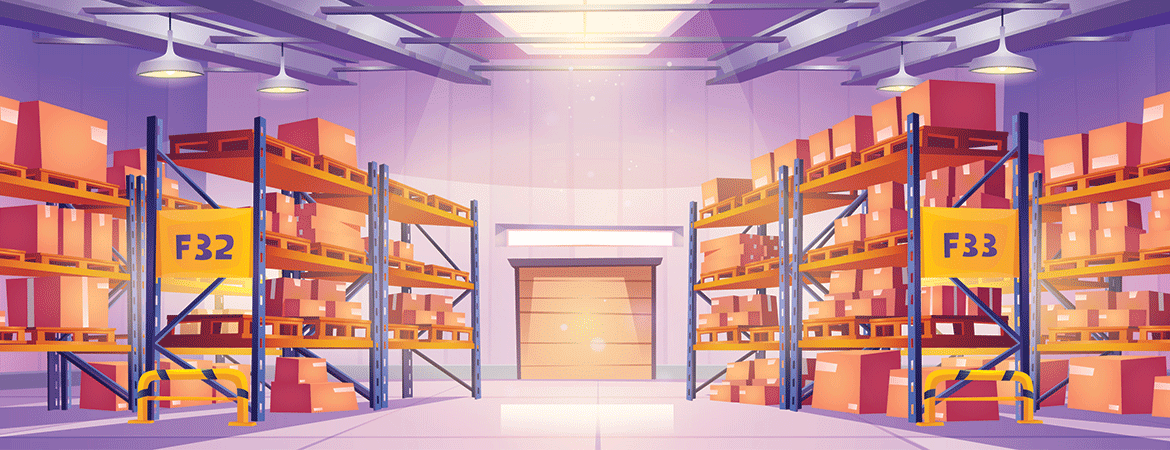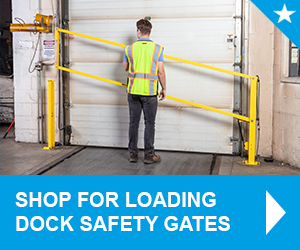
The hallmark of a successful distribution or warehouse operation is a kind of constant bustling order, where employees can maintain a swift, regular pace free of bottlenecks and unnecessary risks. This all depends on how easily staff can adapt to continually moving workplace hazards, especially at loading docks, ladders and stairways, and mezzanines. By making loading dock safety a top priority, safety managers and facility managers can maintain a safe working environment that meets and even surpasses the most stringent application of compliance standards.
Greater Scrutiny for Warehouses and Distribution Centers
Beginning in 2023, The Occupational Safety and Health Administration (OSHA) implemented a three-year National Emphasis Program for warehouses and distribution centers. Facilities across the USA are facing increased scrutiny and the possibility of serious fines – meaning now is the time to ensure your facility’s overall safety strategy is better than ever.
The Scope of Warehouse Safety Challenges
Warehouse and distribution center operations are marked by constant change, but that doesn’t have to mean increased risk. As workers navigate bulky containers and heavy machinery, they must continually plan the safest, most efficient routes around elevated platforms, ladders, and stairways. These transition points limit the type and number of materials they can move, making accessibility an extremely important aspect of warehouse safety.
Safe access control is also vital at loading docks, where manual laborers and industrial vehicles cross paths at the peak of loading/unloading activity. With the right loading dock fall protection safety equipment, safety managers can solve the most critical planning challenges, mitigate the most avoidable accident risks, and reduce the chance of fines.
Between the main work floor and multilevel layouts, it’s loading docks that dictate the overall level of activity throughout the facility. Below, we’ll discuss dock safety tips that can immediately reduce safety risks and establish greater order, both at the loading docks and storage areas.
Loading Dock Safety Tips
#1: Improve Maneuverability
Loading dock safety starts at the loading bay, which involves close contact with shipping containers, but only at exactly the right times. That’s why it’s important to help workers keep their eyes on the task at hand without needless complications.
Vertical lift loading dock gates solve this problem by preserving valuable floor area. Because loading bays take up a wide space, standard loading dock swing gates aren’t ideal. It’s far better to control access without opening gates into floor space. Doing so presents an extra obstacle just as workers must concentrate on safely positioning heavy items. It’s far better to avoid making workers maneuver around safety equipment whenever possible.
#2: Respect Confined Spaces
This same concept applies to smaller safety gates, often used for access control at small stairwells with limited space. A standard vertical lift gate is ideal in confined areas, such as:
- Stairway landings/platforms right at the 30-in. (76 cm) depth and one-stair limit (in the direction of travel) outlined in OSHA 1925(b)(4)
- When open swing gates reduce usable platform space to less than 20 or 22 in. (51 or 56 cm, respectively), depending on the installation date – see OSHA 1910.25[b][5] and Figure D-7 of the same section
#3: Identify Restricted Access Zones
At ground level, a vertical lift gate can also provide a strong visual cue whenever someone enters a restricted access area, including:
- Hoisting areas
- Industrial vehicle zones
- Machine guarding for high-maintenance equipment
- Walking-working surfaces or any area requiring specialty PPE, training, or protocols
#4: Separate Staff From Heavy Equipment Operations When Possible
In conjunction with modular guardrail systems, vertical lift gates can serve access control needs at loading zones. This applies when long, awkward, and heavy objects require more specialized lifting equipment, and only minimal staff. For this reason, a loading dock vertical lift gate could be useful at other places, where larger industrial vehicles or loads must pass.
Because these needs frequently change in a warehouse environment, modularity is essential in your choice of guardrails. They enable quick changeovers by emphasizing easy hand-tool installation and universal fittings for a wide range of:
- Top and midrail sections
- Intermediate members (normally balusters/vertical posts)
- Terminal posts, free of overhangs
- Removable rails that still meet and exceed OSHA force ratings (outlined in OSHA 1910.29[b])
- Industrial swing gates
A single gate and adaptable guardrail is all it could take to protect your workers and good name from OSHA violations associated with powered industrial trucks (see OSHA 1910.178[m]).
The same consideration applies to loading and storage operations at height. Access control and timing is even more essential at mezzanines, where laborers must wait until:
- The load is completely stable
- The forklift or other lifting/raising equipment is out of the way
- The leading edge is no longer exposed
Two-stage mezzanine gates fulfill all these functions by design, blocking access to loads until leading the edge is protected. This dramatically reduces errors related to both fall protection and falling object protection.
Balancing the Technical and Procedural Aspects of Safety
Remember that fall protection safety equipment isn’t limited to elevated working conditions or falling objects alone. Wherever a trip or slip hazard exists, it could exacerbate the risk of falling onto dangerous machinery or into the path of mobile equipment. Such “ground-level” fall, trip, and slip hazards are especially dangerous when heavy loads are involved.
These considerations apply to any of:
- Machine fluids
- Dust and debris
- Floor damage
- Humidity and other ambient conditions
It’s important to take all loading dock fall protection concerns into account when planning your safety gate and guardrail layout. Procedures and training should also reflect these broader considerations.
In the end, loading dock safety requires an equal emphasis on equipment and procedure. Share constant reminders of these important dock safety tips with your crew. It will all-but ensure safe, fine-free operations under the most intense regulatory scrutiny.
Of course, safety managers, lead technicians, and business owners alike must always verify that any given fall protection strategy meets their exact regulatory requirements. Always check your OSHA, CCOHS, or local safety regulations to align your efforts with the most applicable legal requirements in your area.
Maximize Loading Dock Safety for Greater Facility-Wide Compliance
Loading dock fall protection is much more than protecting workers from falling off exposed loading bays. The same dock safety tips discussed here can, more broadly, improve the safety of warehouses and distribution centers overall.
Putting the most innovative fall protection safety equipment at the core of your compliance strategy can help not just meet a wider range of regulatory requirements but prevent the most avoidable safety challenges whenever possible. This is how Fabenco approaches each unique fall protection challenge, engineering our products for maximum versatility and greater value in a variety of scenarios.
Contact us today, and meet the broadest possible range of compliance standards with smart safety equipment investments.





